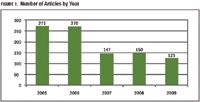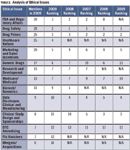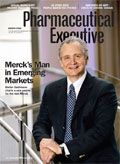Sixth Annual Press Audit
Pharmaceutical Executive
Pricing, promotion, and the unfinished story of healthcare reform dominated the news last year.
A hot topic in c-suite management is the relevance of a new metric of corporate performance: return on reputation. The depth, quality and tone of media coverage is a key determinant of the strength of a company's reputation, which is in turn shaped by broader trends affecting how journalists regard the industry overall. To put weight behind this new metric, Pharm Exec presents its sixth annual audit of media coverage of the biopharmaceuticals industry. Conducted by the Arrupe Center for Business Ethics at St. Joseph's University in Philadelphia, the audit identifies issues that prompted the most media attention over the past year, pinpoints trends in perceptions of the industry, and singles out companies and products with the most citations—good and bad—in the news. This year's evaluation also includes a special focus on how the industry was depicted in the debate on US healthcare reform.
—William Looney
The 2009 audit is a mixed bag of findings. There is evidence of progression in a few areas toward a more favorable image of the industry and individual companies, coupled with a decline in interest and thus coverage of the industry overall. The implication is that corporate efforts around return on reputation require (1) more emphasis on targeted image-enhancing initiatives that address key areas of vulnerability; and (2) a stronger, sustained effort to build positive messaging at the trade association level, because individual company images remain tightly bound to perceptions about the industry overall—one bad apple can easily ruin the batch.

Top of the mark conclusions include:
» Coverage of biopharmaceutical issues fell to a five-year low, with citations in the top five circulating dailies down 18 percent from 2008
» FDA policies and the regulation of risk top the list of hot-button issues, with drug safety falling to number two on the list after ranking first for the previous four years
» Drug pricing demonstrated its staying power as a prominent issue, even with the rise of new topics of interest such as flu vaccines and M&A consolidation
» Industry promotion, marketing, and sales practices carry a very negative slant and interest in this issue is picking up steam
» Tone of coverage in 2009 was less negative toward big pharma, though on balance it is still more negative than positive
» Four of the five large circulation daily newspapers included in the Audit were generally favorable toward the goal of achieving comprehensive health reform, while coverage of Big Pharma's role in reform was primarily—and surprisingly—neutral.
How the Audit Was Conducted
The Audit is a concentrated effort, incorporating data derived over the period from October 1, 2008, to September 30, 2009, from the top five US newspapers, as defined by circulation: USA Today, Wall Street Journal, The New York Times, The Los Angeles Times, and The Washington Post. The purpose of the audit was to shed light on the following questions:
» What ethical and legal controversies face the industry—and what kinds of coverage do they attract?
» Do the articles and headlines support or oppose the positions taken by the industry's lead spokesman, Pharmaceutical Research & Manufacturers' of America (PhRMA)?
» How often do reporters include the industry perspective in their stories?
» What biopharmaceutical companies and product brand names are identified and discussed in the articles?
» What are the implications of these findings for the industry?
Each article was reviewed on the basis of three assessment criteria:
» Relevance, to the priority issues defined by PhRMA in its strategic plan for the year
» Tone, in terms of being positive, negative, or neutral toward the biopharmaceutical industry. For example, any article that called for restrictions or a prohibition on DTC advertising—a position that the industry currently opposes—was deemed negative. In contrast, an article that referenced evidence that DTC advertising results in more informed patients was designated as positive
» Balance, determined by whether stories covered an opposing point of view. When an explicit statement about an opposing view was included in the article—even if the two sides did not receive equal coverage—we concluded that the article covered both sides. When no mention of the opposing view was presented, the article was labeled as one-sided.
What Keeps the Media Up at Night?
Figure 1 shows the total number of articles involving the biopharmaceutical sector for 2009 versus previous years. Results indicate that overall coverage of the industry was down 18 percent year-over-year, or a whopping 55 percent from its peak in 2005. The drop is due in part to an emphasis by journalists on more general topics like healthcare reform.

Figure 1. Number of Articles by Year
Table 2 identifies the issues covered in the articles, the frequency of their coverage, and how the results compare to previous years. For the first time, FDA and regulatory policy issues topped the list in attracting the most media attention, with drug safety a close second. Taken together, FDA and drug safety reveal continuing media scrutiny of the drug-approval process, with particular interest in the misuse or abuse of prescription drugs, adverse effects reporting, and lawsuits related to malpractice and patient claims of injury. As expected, most articles were critical of the industry and/or a specific company or brand.

Table 1. Number of Articles by Newspaper and Section
High drug prices continued to be another major theme in the press, holding a third place rank on the list. Interestingly, two related pricing issues—importation of drugs and differential tiered pricing —received very little attention, and in fact dropped off the list completely. The last audit ranked differential pricing fifth, and in 2006 importation ranked sixth. These shifts may reflect the impact of legislative priorities on the healthcare reform debate, as importation was off the table from the start.

Table 2. Analysis of Ethical Issues
Healthcare reform was the emerging hot issue for the year. The audit separated healthcare reform articles into two segments: those that specifically referred to the response of drugmakers to reform, and those that focused more generally on the healthcare reform movement and debate over its provisions.
A common theme of these articles was the industry's "unexpected" support for healthcare reform, including PhRMA's plan to spend tens of millions of dollars on an advertising blitz promoting the Obama administration's plan to extend healthcare coverage. Another aspect of the debate that attracted strong interest was the commercial implications of expanded healthcare coverage for Big Pharma, where the sentiment was that self-interest was prominent in driving the industry to support the administration's plan.
The audit analysis also showed a renewed focus on coverage of marketing and sales practices in the industry. Attention seems to ebb and flow: The topic drew strong interest in 2005 and 2006, ranking fifth and fourth respectively, before dropping to ninth on the list in 2008, and then re-surging in 2009. This resurgence is due in part to an update to the 2002 PhRMA Guidelines, a voluntary agreement among some 40 pharma companies to stop distributing notepads, pens, T-shirts, soap dispensers, and other reminder items decorated with product logos to doctors and nurses.
Finally, two issues that emerged for the first time were flu vaccines and industry mergers/acquisitions and consolidation. This is not surprising given concerns about swine flu and the buzz around Pfizer's acquisition of Wyeth.
Tracking the Negatives
An overall drop in coverage in 2009 proved to have a silver lining, due to the fact that negative coverage remains the norm when journalists write about the industry. This slant has been consistent over the six years of the study. The good news for 2009 is that the proportion of both negative headlines and negative articles declined from previous years—though articles were still four times more likely to be negative than positive toward the industry. (See Table 4.)

Table 4. Analysis of Headlines and Full Articles
And which news daily gets the prize for most negative coverage of the industry? This year's audit examined all 420 articles from the database over the past three years. The results shown in Table 5 indicate that The New York Times wins that distinctive label by a wide margin, followed by USA Today. In contrast, The Washington Post and Wall Street Journal were most likely to publish a positive article about the industry.

Table 5. Three-Year Analysis of Newspaper Articles
Wyeth Draws Strongest Interest
The audit also tracks level of interest in companies and their brands. Cited most frequently were Wyeth, Pfizer, and Merck, each of which was involved in major news stories involving merger and acquisition activities. Brands attracting the most attention were Wyeth's Phenergan and the Pfizer blockbuster Lipitor; in the former case, it was the heady whiff of scandal linked to a key liability ruling around negligence in administration of a powerful drug; for Lipitor, the coverage was due to its status as symbol for the "patent cliff" challenge confronting the industry over the next few years. In addition, Novartis received coverage of its attention-deficit/hyperactivity disorder (ADHD) and narcolepsy drug, Ritalin (methylphenidate hydrochloride), while Pfizer featured prominently for its $2.3 billion fraud settlement for civil and criminal allegations that it illegally marketed the painkiller Bextra. (See Table 10.)

Table 10. Companies Identified
Top of Line: Healthcare Reform
Healthcare reform established a presence in the top five newspapers with 86 citations, almost 90 percent of which occurred over the last five months of the audit's reporting period. The Washington Post accounted for half of the total coverage, with its editorials doubling the number of front page articles. The Los Angeles Times had a comparable number of front page articles but not nearly as many editorials.
Four of the five newspapers held opinions that were generally supportive of healthcare reform. The Washington Post was more supportive than the other newspapers by virtue of the volume of its coverage and its favorable opinion about the public option for insurance coverage. Although they were generally supportive, The New York Times and Los Angeles Times laced their articles with healthy skepticism. Interestingly, coverage by the Wall Street Journal was sparse, with only three articles, and the paper was primarily negative in placing strong emphasis on the cost of reform.
Coverage by all five newspapers accelerated during the second half of 2009, with greater attention given to healthcare reform by Congress. However, the results in Table 6 do not include the fourth quarter of 2009, which fell after the end of the audit period.

Table 6. Number of Articles
Healthcare Reform and Pharma
Following the same methodology, the top five US newspapers were analyzed to shed light on the following questions:
» Do healthcare articles and headlines support or oppose the positions taken by the industry?
» What ethical issues face the pharma industry in these articles on reform?
» How often are the industry's perspectives included in the articles?
» What pharmaceutical companies and/or brand names are identified in the articles?
» What are the implications of these findings for the industry?
For each article reviewed, its headline was judged as positive, negative, or neutral toward the industry. Additionally, each article was analyzed in the same way. The conclusion was that the headlines were overwhelmingly neutral toward the industry (88.5 percent) while the full articles were generally neutral toward pharma (70.9 percent)—this despite the articles being mostly favorable about healthcare reform. (See Table 7.)

Table 7. Analyses of Headlines and Full-Text Articles
The audit found that The New York Times and USA Today were negative toward the industry, while the other three newspapers were primarily neutral toward the industry—particularly The Washington Post, in which 33 of 43 articles were neutral. (See Table 8.)

Table 8. Analysis of Full-Text Articles by Newspaper
Healthcare Reform and Ethical Concerns
Each article was also analyzed to determine whether it contained any underlying ethical issues specific to the pharmaceutical industry. The audit found two of note: a subtle bias against high drug prices (19 mentions) and references to the importance of Medicare/Medicaid coverage for drugs (11). After these two issues, the economy and its connection to paying for healthcare reform was mentioned five times. Sixteen other issues ranging from insurance accessibility and costs to electronic health records were mentioned once or twice. (See Table 9)

Table 9. Analysis of Ethical Issues
Coverage was also evaluated to see if it included the opposing point of view. In most cases, this was included.
Assessing the 2009 Audit
The pharmaceutical industry is failing to inspire favorable coverage in two areas over which it has direct control—drug prices and marketing and sales incentives—which are responsible for 37 percent of media coverage. The industry can get positive or at least neutral coverage when it talks about price reductions. Significant price increases taken during 4Q 2009, however, suggest that prices will be a high-ranking issue for the industry again in next year's audit.
Marketing and sales incentives are another issue that the industry can control, but instances of aberrant behavior by individual companies continues to drag the industry down. Last year's audit noted Lilly's $1.4 billion fine for its off-label promotion of Zyprexa. Pfizer's 2009 fine—nearly twice Lilly's penalty—suggests that this will remain a hot-button issue. These activities negate the support the industry gained for its work to provide Congress with a viable alternative for the Medicare drug benefit in healthcare reform, and suggest that self-regulation isn't likely to protect the industry from legislative action to rein in its worst practices. Media interest in the human element created by misappropriation of the "public trust" suggests that coverage of these two issues—pricing and promotion—will stoke the concerns of the political community and challenge the capacity of the industry to prevail through improved reputational assets.
Stephen Porth is an associate dean, Arrupe Fellow, and professor at St. Joseph's University. George Sillup is an Arrupe Fellow and assistant professor at St. Joseph's University. Cynthia Slater, Molly Porth, Leanna Baselice, and Courtney Scardellette also contributed to this research.
The Misinformation Maze: Navigating Public Health in the Digital Age
March 11th 2025Jennifer Butler, chief commercial officer of Pleio, discusses misinformation's threat to public health, where patients are turning for trustworthy health information, the industry's pivot to peer-to-patient strategies to educate patients, and more.
Navigating Distrust: Pharma in the Age of Social Media
February 18th 2025Ian Baer, Founder and CEO of Sooth, discusses how the growing distrust in social media will impact industry marketing strategies and the relationships between pharmaceutical companies and the patients they aim to serve. He also explains dark social, how to combat misinformation, closing the trust gap, and more.
